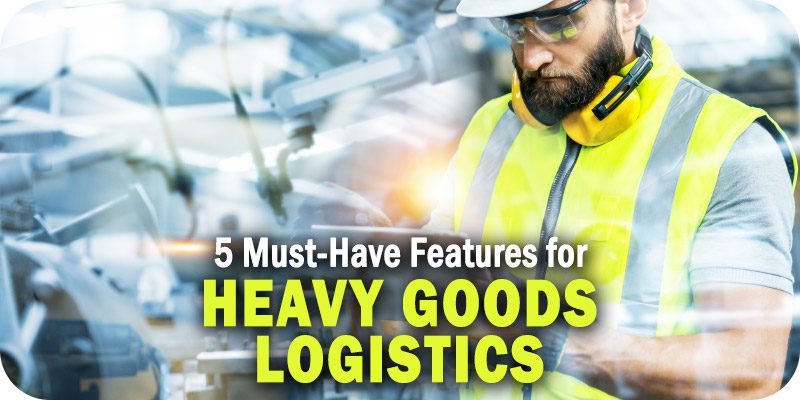5 Must-Have Features for Your Heavy Goods Logistics Solution


As part of Solutions Review’s Contributed Content Series—a collection of articles written by industry thought leaders in maturing software categories—Doug Ladden, the co-founder & CEO of Deliveright, outlines the five features every heavy goods logistics solution should offer.
Digital transformation is driving disruption in supply chain logistics. Today’s landscape calls for advanced flexibility and agility (i.e., the removal of boundaries). Visibility, flexibility, and agility across a company’s supply chain are critical and usually require companies to integrate Warehouse Management Systems (WMS) and Transportation Management Systems (TMS) for the most comprehensive view of Supply Chain Management (SCM) processes.
Many companies, especially those delivering heavy goods, are struggling to keep up with a supply chain in flux, while others have fared better, having adapted to today’s challenges. With so many moving pieces, ensuring on-time deliveries, prioritizing customer satisfaction, and managing returns are all key. Building a technology foundation is the first step toward success. Knowing what to look for in a technology-fueled heavy goods logistics solution is crucial for optimizing your company’s delivery process and enhancing SCM.
A Customizable Dashboard
Most people interact with optimally designed user interfaces daily, from computers and cell phones to self-checkout stations at the grocery store. Although choosing a solution with an effective delivery dashboard may seem daunting, business leaders instinctively know what user interface will best meet their particular needs. Determining the solution that suits the company’s needs is about exploring possibilities and understanding which features will support business goals.
Start by identifying a customizable solution that can be tailored for the business, regardless of whether the company is a big e-commerce operation shipping millions of orders or a growing vendor that needs to automate operations. Uniformity, simplicity, and transparency are essential features. This includes connecting warehousing information for a product, the associated freight activity report, all electronic documentation for every stop along the route, and an ETA that’s updated in real-time until the delivery is final. A cloud-based platform ensures up-to-the-minute information and easy access to delivery details throughout the delivery process. Some companies offer a try-before-you-buy option, removing the guesswork.
A solid delivery dashboard saves time and avoids redundancies by keeping everyone in the loop, allowing for an increased focus on tracking relevant KPIs and data. These insights drive increased operational efficiency and, ultimately, satisfied customers.
Integrated Communications
When implementing a new solution, one significant stressor is keeping every team member in the know. Many business owners delay necessary updates for fear of disruption caused by poor communication. A system that elevates communication starts working the moment it goes into place and continues to prove its worth.
A live-functioning distribution management system (DMS) tracks logistics and allows companies to establish logical automation for communication, reducing time wasted by sending countless emails to team members and customers. An ideal, integrated communications system will customize the level of visibility for a given user based on individual roles. With the right platform, programming specific notifications for crucial information related to a product, like receiving, planning, and customer updates, is simpler to achieve.
Route Optimization
Professionals know that route optimization improves the chance that deliveries will make it to their destination efficiently. But the reality is that traditional routing practices are outdated and will fail to sustain operations in a competitive market. As digital transformation continues to take hold across the industry, employing tools to help select and manage routes can be the difference between a successful delivery or a disappointed and frustrated customer.
An effective heavy goods logistics solution should optimize routes, accounting for all factors—even the less predictable ones. Today’s innovative technology solutions can automatically hone delivery routes even when faced with factors like weather, customers with changing delivery preferences, traffic, and unforeseen complications. But even if everything goes according to plan, costs must still be managed, and trucks must run efficiently. Routes and schedules should make sense time-wise and distance-wise.
Accounting for basic factors means taking a strategic approach to capitalizing on every shipment, including, for example, optimizing fuel efficiency and space: a half-full truck is inefficient, but waiting until a truck reaches capacity before making deliveries is suboptimal as well. Leveraging an approach that covers various distribution models, including determining how many trucks should be allocated daily or weekly for each route, helps to build the most efficient strategy. Winning models run automatically and rebalance trucks’ distribution as changes arise—or even before.
It’s essential to select a platform with an interface simple enough to accommodate easy adjustments to routes well in advance of the delivery dates and once a delivery is en route. Ideally, the platform can react to changes after the truck has left the hub, enabling re-routing for modifications requested by the customer, which traditionally would entail rescheduling, sacrificing revenue and time.
Route optimization is the greener option, and customers now pay more attention to company environmental policies. Customers feel good about ordering from an organization that considers sustainability in its operations.
Data and Analytics
One of the most significant advantages of an increasingly automated logistics industry is unprecedented access to internal data. Specifically, data helps inform business decisions and drive positive outcomes. Innovative technology can generate business intelligence reports, including freight volume, sales and order fulfillment, inventory, profit and loss analysis, customized reports based on client profiles, time settings, the margin by customer, and more.
Data is the most valuable resource a company has for driving informed decision-making. Analyzing supply chain and logistics quality data can help save work hours and improve problem-solving. Companies can use insights to predict damage potential, specify service and delivery times, account for trailer load factors, optimize inventory cycling, strategize routes, track product and sales trends, and more.
White Glove Delivery
White glove delivery is the essence of an exceptional customer experience and is made possible by ensuring business operations are buttoned up for seamless interactions. While white glove delivery isn’t built into a single solution, the resources enabling it are. Choosing a solution that offers the first four items on this list provides the opportunity to deliver on the all-important number five.
White glove delivery is essential for large, bulky, and heavy goods. It means bringing a new sofa into the customer’s home, assembling it, and removing boxes or wrapping instead of simply delivering the package to the curb. It entails providing all the information a buyer needs about their new washing machine and considering the delivery complete only once it’s connected and functioning.
The white glove difference is all about attending to the customer experience and the difference between a three-star and a five-star review—which can, in turn, be the difference between the next shopper clicking “purchase” or scrolling past a competitor’s item.
The Final Mile
The final mile is the most important and, traditionally, the most cumbersome aspect of delivery (white glove or otherwise). In this final stage of the supply chain, the product moves from a nearby hub into the customer’s home. The supply chain and logistics industry is set to benefit enormously from digital transformation by automating previously manual processes, an opportunity for companies to prove that customer satisfaction is a priority.
Ultimately, a heavy goods logistics solution should do everything, from offering customizable options for receiving and inventory management to customer scheduling, truck routing, outbound freight management, and even invoicing. In this customer-centric environment, automation paves the way toward success—ensuring a seamless, problem-free experience every time.























